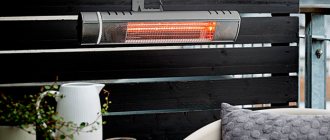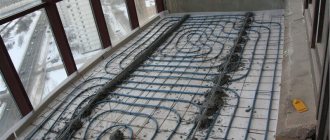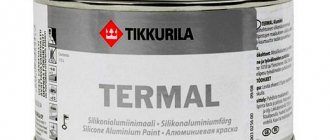An insulated loggia is an excellent option for expanding the usable area of an apartment. At the same time, high-quality glazing, insulation and waterproofing are not enough for a comfortable stay in the loggia throughout the year. This is why many owners decide to move the battery to the loggia.
Good heating of the loggia.
It’s worth noting right away that this is a rather labor-intensive process, which, among other things, is not so easy to coordinate with the housing inspection.
First you need to develop a project, then obtain permits, and only then carry out all the necessary installation work, which is not as simple as it seems.
Lonely battery on the loggia.
What to consider?
The idea of moving a heating radiator to the loggia is a good idea for creating a comfortable environment in this non-residential space during the cold season.
In this case, the following must be taken into account:
- To carry out such work, you must obtain permission. You can’t just take and dismantle the heating radiator in the room and install it in the loggia. It is also prohibited to add new elements to the apartment’s heating system without approval from the relevant authorities. At the same time, no one can guarantee that after contacting the housing inspection it will be possible to get a positive response from them regarding the transfer of the battery to the loggia - homeowners are not always given such permissions. In addition, this is a rather complex bureaucratic procedure that can last more than one month.
- Perform accurate calculations. All work must be performed professionally, therefore, calculations regarding the number of sections of the heating radiator in the loggia, its location, ambient temperature, and pressure in the pipeline must be entrusted to professionals. After all, adding a new battery is fraught with consequences for the apartment owners and their neighbors.
- Carrying out insulation work. Of course, there is no point in moving the battery into the loggia if high-quality glazing and insulation have not been done. All surfaces of the loggia must be insulated. Glazing – preferably two-chamber or three-chamber.
Connection diagram
The most effective option is the radiator mounting scheme with a jumper. This will allow you not to move the riser, leaving the kitchen or room radiator in place, and to manipulate the balcony radiator due to the presence of shut-off valves, including calmly dismantling the device. Therefore, after attaching the battery, you need to break through the wall and lead the pipe strictly horizontally from the riser.
After installing the device, connect the battery to the riser and enjoy the benefits of the heated additional room.
Thus, with a competent and legal approach, it is quite possible to increase the number of square meters in an apartment due to a heated balcony. But whether to do this with the use of a central heating battery or to use alternative options is up to the owner of the premises.
Related article: How to glaze a loggia with your own hands
Bureaucratic issues
The housing inspection will require apartment owners to:
- Professionally performed thermal conductivity calculations;
- A professional opinion from specialists that the water in the heating radiator will not freeze outside the apartment;
- The redevelopment project and a number of other documents, the list of which must be clarified with the regional housing inspection.
Moreover, the most difficult stage will be the development of a redevelopment project, which involves changing the status of the loggia.
From a non-residential premises it must be transformed, strictly according to the documents, into a living room. The author of the apartment building project (usually a company or design institute) is responsible for issuing such documents.
It is worth noting that the development of the status change project itself is carried out by specialized firms.
In a project, the specialist responsible for its development must take into account all the nuances and standards (construction, sanitary, fire safety, engineering, communications, etc.). Of course, before developing a project, it is necessary to properly insulate the room and take into account possible risks.
The design institute usually gives such permissions if the removal of the central heating radiator does not affect the condition of the entire building. That is why, in most cases, there are no problems with obtaining permission in new buildings and relatively new houses, while in houses of the old housing stock it will be practically impossible to carry out such work officially.
After all this, it is necessary to develop design documentation, which must be agreed upon with Rospotrebnadzor and the fire service. At the end of everything, it is necessary to register the redevelopment with the BTI, where the corresponding changes will be made to the title documents.
Choosing a radiator
When the procedure for obtaining permission has been successfully completed, it is time to choose a room heating element that is suitable for the loggia.
All batteries are divided into 3 types:
- economy segment;
- middle class;
- premium
The main criteria for differences are cost, quality of materials and duration of operation.
Cast iron
The best and most durable metal of all times has been and remains cast iron. The shelf life of such radiators is more than 35 years. They are stronger than analogs made from other materials, but they weigh a lot. It is recommended to install it on the loggia only from the side of the house wall. The balcony can support no more than 600 kg of weight.
We recommend: How to choose a bed?
There is no need to additionally load it, because there is an installed double-glazed window, finishing, tiles on the floor (or other covering), and furniture. They look quite massive and the classic look does not always fit into a modern interior.
Aluminum
They weigh much less, are made in a modern design, and conduct heat well. The only negative: they can rust and deteriorate if the water they receive is of poor quality. Recommended for private homes where the source of water is known and autonomous.
Bimetal
Radiators of this type are most often used in apartment buildings. Bimetallic structures are compact and look laconic. They come in different sizes, conduct and release heat well. Ideal for a balcony or loggia due to its light weight and versatility in installation.
Is illegal installation possible?
Naturally, very often you can find cases where the removal of a heating radiator into the loggia is carried out without any approval. Moreover, all installation work is carried out independently, because many mechanics and craftsmen will definitely ask to see permits before starting the installation of a heating radiator. If they do not exist, then few specialists will engage in such work.
Illegal removal of a heating radiator onto a balcony is punishable by a fine. In accordance with the current Code of the Russian Federation on Administrative Offenses, the fine is several thousand rubles. In addition, it will be necessary to carry out work to dismantle the radiator and return everything to its place.
However, after the work has been completed, you can try to get started with paperwork and legalization of the redevelopment.
Although this is a complex process, such a development of events still has the right to life. If the apartment owner refuses to pay fines or remove the heating radiator from the loggia, then the housing company may take extreme measures - go to the courts.
Sequencing
So, the legal and technically correct sequence of actions if you want to place a heating radiator on the balcony consists of the following steps:
- insulation of external walls;
- coordination of redevelopment, obtaining relevant permits and conclusions;
- choosing the optimal type of radiator and installation method;
- wall preparation - installation of thermal insulation, finishing;
- direct installation.
Article on the topic: What material is better to decorate a balcony inside
? If you are firm in your intentions, then for apartment buildings it is recommended to move the radiator from the room to the balcony, and not install an additional one, which will immediately significantly reduce the efficiency of the common house system - this is unlikely to please the neighbors and will lead to checks behind you.
Features of installation work
After obtaining permission and completing all documents for the removal of the central heating radiator to the loggia, work can begin. In this case, it is necessary to take into account all the nuances that will allow you to correctly remove the heating radiator:
- An excellent solution for a loggia would be modern aluminum radiators, which have many advantages: light weight and modest size, the ability to work with fairly high pressure in the pipeline, and an increased degree of thermal conductivity (which, in principle, is what is required to generate heat).
- If aluminum batteries were chosen, then the number of heating radiator sections must be calculated using the formula - one section per two square meters of balcony area. For example, if the balcony has an area of 6 sq. m., then an aluminum radiator with three to four sections will be enough.
- Mounting the battery on the balcony, regardless of its type, must be done using three brackets: one upper and two lower. If the heating radiator is large, you can add another top mount.
- To obtain a high degree of heat transfer, it is necessary to maintain the following distances from the main structural elements of the loggia. The battery should be installed 14 cm from the floor, 2-3 cm from the wall, 8-12 cm from the window.
- In addition, before installation, it is recommended to lay a foil screen behind the intended installation of the heating radiator, which will provide warmth and comfort.
Types of batteries installed on balconies and loggias
If your decision to move the heating radiator to the balcony is final and firm, and you have received the necessary documentation and permits for it, you should be faced with another important issue: choosing the right type of battery.
Today, the range of products of this kind, made from various materials, presented on the market is quite wide. It includes batteries of the following classes:
| CLASS | MATERIAL OF MANUFACTURE |
| "ECONOMY" | Cast iron |
| Steel | |
| "AVERAGE" | Steel tubular |
| Aluminum | |
| Bimetallic | |
| "PREMIUM" | Improved bimetallic |
| Cast iron designer | |
| Aluminum cast |
Related article: Strengthening the balcony in Khrushchev
It is worth noting that heating batteries made of cast iron, which is characterized by high strength and durability, have the longest service life (about 35 years). However, radiators of this type do not have very high inertia, that is, they take a long time to warm up and take a long time to cool down.
Steel batteries, which are usually divided into two types depending on the design features: tubular and panel, will last about 10-15 years. Their advantage: high heat transfer. Moreover, panel-type radiators with excellent technological characteristics and affordable cost are in greatest demand.
Tubular steel heating radiators are much more expensive, but they have a more interesting design solution and can be produced in a large number of colors and sizes. Among them, it is worth highlighting stainless steel products, which have the highest cost and the best consumer qualities.
Average service life of aluminum radiators. It is 15-20 years. Their advantages: original design, minimal weight, high thermal conductivity and small size. Due to these advantages, aluminum sectional batteries, along with bimetallic ones, are the most popular.
Important: Aluminum radiators are sensitive to the PH level of the coolant, so they are recommended to be installed in private houses with an autonomous heating system.
For a city apartment, the best option would be bimetallic radiators that are resistant to water hammer, independent of the quality of the coolant and have good heat transfer.
Stages of work
Before heating the loggia, it is necessary to dismantle the old radiator in the room, if planned.
To complete the work you will need: pipes, brackets, a hammer drill, fittings, a grinder, a soldering iron.
In most cases, installation of a heating radiator in a loggia is carried out in the following sequence:
- The first step is to cut off the battery in the room (kitchen, living room, bedroom). You need to cut in two places: near the battery and the pipe (about 100 mm from the intended connection area). After this, you need to drill holes in the wall with a diameter of 20 mm, which will allow you to carry the riser into the loggia. First, the roll is removed, after which the fittings, connections, and finally the riser itself are installed.
- A good solution would be to choose polypropylene pipes, which have excellent performance characteristics. In addition, when using them, it will be easier to complete all installation work yourself.
- Next, you need to attach the new battery to the wall in the loggia in order to use a level to mark the areas for future fastenings. Then the brackets are installed. It was already noted above that it is necessary to install two lower and one upper bracket. For a small radiator this will be quite enough.
- Hanging the battery on the loggia on the installed brackets is quite simple. After installing the radiator, Mayevsky plugs and taps are installed.
- If polypropylene pipes were used, then various elements (fittings, connections) were attached to them.
- After this, the taps are installed and the pipes are connected. It is imperative to check the tightness of the installed pipes and all connections.











